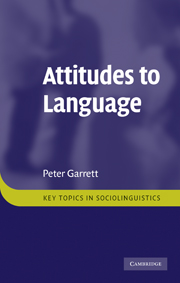Book contents
- Frontmatter
- Contents
- List of figures
- List of tables
- Acknowledgements
- 1 Introduction
- 2 Fundamentals of language attitudes
- 3 Main approaches to the study of language attitudes
- 4 Matched and verbal guise studies: focus on English
- 5 Matched and verbal guise research in more contexts
- 6 Attitudes to speech styles and other variables: communication features, speakers, hearers and contexts
- 7 Communication accommodation theory
- 8 Language attitudes in professional contexts
- 9 Societal treatment studies
- 10 Direct approach
- 11 Folklinguistics
- 12 An integrated programme of language attitudes research
- 13 Conclusion
- Glossary
- References
- Index
- References
12 - An integrated programme of language attitudes research
Published online by Cambridge University Press: 05 June 2012
- Frontmatter
- Contents
- List of figures
- List of tables
- Acknowledgements
- 1 Introduction
- 2 Fundamentals of language attitudes
- 3 Main approaches to the study of language attitudes
- 4 Matched and verbal guise studies: focus on English
- 5 Matched and verbal guise research in more contexts
- 6 Attitudes to speech styles and other variables: communication features, speakers, hearers and contexts
- 7 Communication accommodation theory
- 8 Language attitudes in professional contexts
- 9 Societal treatment studies
- 10 Direct approach
- 11 Folklinguistics
- 12 An integrated programme of language attitudes research
- 13 Conclusion
- Glossary
- References
- Index
- References
Summary
Earlier in this book, it was mentioned that many language attitudes studies are relatively small-scale ‘one-off’ studies. Cumulatively, by gradually exploring more aspects of language attitudes, they provide the bedrock of what we know and understand about language attitudes, and, also as mentioned and elaborated earlier, we have to acknowledge that particular research methods have their own advantages and limitations. In this chapter we will consider an instance where a range of methods were integrated into the same language attitudes project. Often such work is not feasible, since it requires considerable resources devoted to one area of language attitudes. Usually studies have to be carried out on a smaller scale. But consideration of this multiple-method programme of research offers an opportunity to show how methods can complement each other.
In terms of content, the study provides insights into attitudes towards varieties of English spoken in different parts of Wales, the setting of this research. It is a common feature that findings from one study throw up questions or new issues to be investigated in future research, and in earlier studies of attitudes towards Welsh English there had been some diversity in findings that were worth exploring. For example, while Welsh English had been found to be more favourably evaluated than RP, and on a par with the Welsh language itself (Bourhis et al. 1973), it had elsewhere been downgraded in relation to both Welsh and RP (Price et al. 1983).
- Type
- Chapter
- Information
- Attitudes to Language , pp. 201 - 223Publisher: Cambridge University PressPrint publication year: 2010

